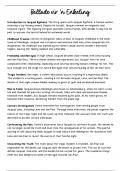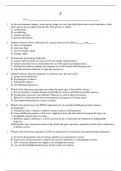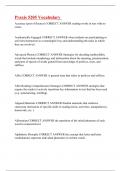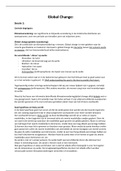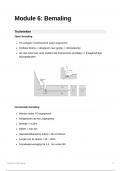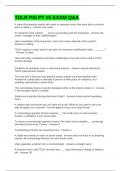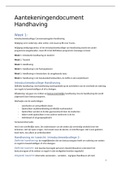Summary Articles Business Intelligence & Analytics
Lecture 1 articles: 2
Big Data: Extending the business strategy toolbox. (Woerner & Wixom) 2
The New Patterns of Innovation (Parmar et al., 2014) 3
Big Data, Analytics and the Path from Insights to Value (LaValle et al., 2011) 5
Big Data for Big Business? (Hartmann et al., 2014) 8
Lecture 2 Articles 12
Data quality in context ,Communications of the ACM - Strong et al., 1997 12
Big Data for all: privacy and user control in the age of analytics - Tene & Polonetsky., 2013 14
One size does not fit all a contingency approach to data governance - Weber et al., 2009 17
Lecture 3 Articles 21
An overview of Business Intelligence Technology - Chaudhuri et al., 2011 21
Using Knowledge Management to create a data hub - Ferreira et al., 2018 24
Data warehouses, Business Intelligence System, and Big Data - Kroenke et al., 2017 28
Week 4 Articles 30
Contemporary Business Analytics: An Overview. Raghupathi & Raghupathi., 2021 30
Chapter 14: Association Rules and Collaborative Filtering. Shmueli et al., 2016 35
Classification Models. In Data Mining with SPSS Modeler. Wendler & Gröttrup., 2016. 35
Classification algorithms - assigning a category to each input variable vector. The target variable is
categorical. Classification models belong to the supervised learning algorithms. The models learns
from some training data and then predicts the outcome of the response variable based on this training
data. 35
Cluster Analysis. In Data Mining with SPSS Modeler. Wendler & Gröttrup., 2016. 39
Week 5 Articles 41
Cosic, R., Shanks, G., & Maynard, S. B. (2015). A business analytics capability framework. 41
Fogarty, D., & Bell, P. C. (2014). Should you outsource analytics? 42
Wixom, B. H., & Watson, H. J. (2001). An empirical investigation of the factors affecting data
warehousing success 43
Week 6 Articles 43
Cairo, A. 2020. If Anything on This Graphic Causes Confusion, Discard the Entire Product 43
Chen, C. (2010). Information visualization. 44
Schwabish, J. A. (2014). An Economist's Guide to Visualizing Data. 44
Wong, B. 2010. Gestalt principles (Part 1) 45
Wong, B. 2010. Gestalt principles (Part 2) 46
,Lecture 1 articles:
Big Data: Extending the business strategy toolbox. (Woerner & Wixom)
The business world is digitizing quickly due to sensors, mobile devices, and the internet which can predict
needs, avert fraud and waste, understand relationships, and connect with stakeholders both internal and
external to the firm.
Digitization creates challenges for companies because it is distributed unevenly throughout the company.
Improve the business model:
● New data
○ more transparency of end-consumer visibility, allows to understand customer preferences
and behavior due to i.e., customers posting on social media
● New insight
○ new big data approaches and techniques that ranged from high-end statistics and models
to colorful visualizations of the output.
● New action
○ due to big data and ability to make insights based on the data, companies can act
differently – faster and more wisely.
Innovate the business model:
● Data monetization
○ is the act of exchanging information-based products and services for legal tender or
something of perceived equivalent value.
○ information-based products and services can include a range of offerings that increase in
complexity:
■ capabilities and skills requirements, potential for financial returns, raw data,
enhanced data, reporting and analytics, process design, and process executing.
○ Requires a dedicated unit in the company that helps manage and govern the data
monetization business model.
○ Companies are monetizing by selling, bartering, and wrapping
■ wrapping refers to wrapping information around other core products and services.
Potentially increase prices, markets share, customer lifetime value etc.
■ selling occurs when companies receive money or some form of legal tender in
exchange for information offerings.
■ bartering occurs when companies choose to trade information in return for new
tools, services, or special deals.
● Digital transformation
○ creates increased amounts of new and different types of data, and also has the potential to
blur company boundaries so that it becomes more difficult to tell where a partner
organization engagement begins and ends.
○ ecosystems offer more choice, information, and value to consumers, and how much deep
knowledge of the end consumer a company currently has or in which it is willing to
invest becomes a key dimension for company strategy.
,Big data can enable companies to transform in ways that lead them into new industries or ecosystems and
alters traditional competitive landscapes. Those companies that understand customers’ needs best – likely
from using big data – and deliver upon that understanding win.
Big data is not necessarily an obstacle to strategy, instead it offers rich, exciting opportunities to leverage
and extend a company’s business strategy toolbox.
The New Patterns of Innovation (Parmar et al., 2014)
Reasons for the failure of new business ideas and new business models:
● Managers who are skilled at executing clearly defined strategies are ill equipped for
out-of-the-box thinking.
● When good ideas emerge in a company they are often doomed because the company is organized
to support one way of doing business and doesn’t have the processes or metrics to support a new
one.
● The Odds of success are increased if you tackle business innovation systematically. Tested ways
of framing the search for ideas are i.e.,
○ How can we build on the capabilities and assets that already make us distinctive to enter
new businesses and markets?
○ What does a close study of customers’ behavior tell us about their tacit, unmet needs?
○ If we follow “megatrends” or other shifts to their logical conclusion, what future business
opportunities will become clear?
○ The authors propose a fourth approach:
How can we create value for customers using data and analytic tools we own or could
have access to?
The five patterns that followed from the question above are:
● Augmenting products to generate data
○ Using data that physical objects now generate (or could generate) to improve a product or
service or create new business value
○ Relevant questions:
■ Which of the data relates to our products and their use? Which do we now keep
and which could we start keeping? What insights could be developed from the
data?
● Digitizing (physical) assets
○ Management of digitization itself could be a new business. Many industries need a
long-term, secure way to store their digital assets. Thus, successfully managing its own
data could provide the capability of preservation and access-control requirements as a
service to others, regardless of industry.
○ Relevant questions:
, ■ Which of our assets are either wholly or essentially digital? How can we use their
digital nature to improve or augment their value? Do we have physical assets that
could be turned into digital assets?
● Combining data within and across industries
○ Science of big data, along with new IT standards that allow enhanced data integration,
makes it possible to coordinate information across industries or sectors in new ways.
■ I.e, shared-delivery services
○ Relevant questions:
■ How might our data be combined with data held by others to create new value?
Could we act as the catalyst for value creation by integrating data held by other
players?
● Trading data
○ A company whose information is valuable to another company sells it.
○ Ability to combine disparate data sets allows companies to develop a variety of new
offerings for adjacent businesses.
○ Relevant question:
■ How could our data be structured and analyzed to yield higher-value
information? Is there value in this data to us internally, to our current customers,
to potential new customers, or to another country?
● Codifying a distinctive service capability
○ Allows a company to take any process in which it is best-in-class and sell it to other
companies, using cloud computing.
○ Relevant questions:
■ Do we possess a distinctive capability that others would value? Is there a way to
standardize this capability so that it could be broadly useful? Can we deliver this
capability as a digital service?
Third wave of IT-enabled innovation is being powered by three drivers:
● Explosion in digital data
○ Digitization is making massive amounts of data readily available. Data about suppliers
and partners can be had in near real time, customers are increasingly willing to share all
manner of information and wired objects (IoT).
● Better tools for data
○ Capacity to integrate, analyze, and exploit structured data continues to improve, and our
ability to understand and learn from data has been transformed.
● Business in the Cloud
○ As business becomes more virtual, its nature changes. The digitization of business
generates opportunities to reduce operating costs and to create new offerings for
customers.
Successful initiatives had four things in common:
● Strong Technology Presence
○ Having the CIO/ CTO for IT plays a major role in the project. This role should be
focused on the business value creation rather than business efficiency.
Lecture 1 articles: 2
Big Data: Extending the business strategy toolbox. (Woerner & Wixom) 2
The New Patterns of Innovation (Parmar et al., 2014) 3
Big Data, Analytics and the Path from Insights to Value (LaValle et al., 2011) 5
Big Data for Big Business? (Hartmann et al., 2014) 8
Lecture 2 Articles 12
Data quality in context ,Communications of the ACM - Strong et al., 1997 12
Big Data for all: privacy and user control in the age of analytics - Tene & Polonetsky., 2013 14
One size does not fit all a contingency approach to data governance - Weber et al., 2009 17
Lecture 3 Articles 21
An overview of Business Intelligence Technology - Chaudhuri et al., 2011 21
Using Knowledge Management to create a data hub - Ferreira et al., 2018 24
Data warehouses, Business Intelligence System, and Big Data - Kroenke et al., 2017 28
Week 4 Articles 30
Contemporary Business Analytics: An Overview. Raghupathi & Raghupathi., 2021 30
Chapter 14: Association Rules and Collaborative Filtering. Shmueli et al., 2016 35
Classification Models. In Data Mining with SPSS Modeler. Wendler & Gröttrup., 2016. 35
Classification algorithms - assigning a category to each input variable vector. The target variable is
categorical. Classification models belong to the supervised learning algorithms. The models learns
from some training data and then predicts the outcome of the response variable based on this training
data. 35
Cluster Analysis. In Data Mining with SPSS Modeler. Wendler & Gröttrup., 2016. 39
Week 5 Articles 41
Cosic, R., Shanks, G., & Maynard, S. B. (2015). A business analytics capability framework. 41
Fogarty, D., & Bell, P. C. (2014). Should you outsource analytics? 42
Wixom, B. H., & Watson, H. J. (2001). An empirical investigation of the factors affecting data
warehousing success 43
Week 6 Articles 43
Cairo, A. 2020. If Anything on This Graphic Causes Confusion, Discard the Entire Product 43
Chen, C. (2010). Information visualization. 44
Schwabish, J. A. (2014). An Economist's Guide to Visualizing Data. 44
Wong, B. 2010. Gestalt principles (Part 1) 45
Wong, B. 2010. Gestalt principles (Part 2) 46
,Lecture 1 articles:
Big Data: Extending the business strategy toolbox. (Woerner & Wixom)
The business world is digitizing quickly due to sensors, mobile devices, and the internet which can predict
needs, avert fraud and waste, understand relationships, and connect with stakeholders both internal and
external to the firm.
Digitization creates challenges for companies because it is distributed unevenly throughout the company.
Improve the business model:
● New data
○ more transparency of end-consumer visibility, allows to understand customer preferences
and behavior due to i.e., customers posting on social media
● New insight
○ new big data approaches and techniques that ranged from high-end statistics and models
to colorful visualizations of the output.
● New action
○ due to big data and ability to make insights based on the data, companies can act
differently – faster and more wisely.
Innovate the business model:
● Data monetization
○ is the act of exchanging information-based products and services for legal tender or
something of perceived equivalent value.
○ information-based products and services can include a range of offerings that increase in
complexity:
■ capabilities and skills requirements, potential for financial returns, raw data,
enhanced data, reporting and analytics, process design, and process executing.
○ Requires a dedicated unit in the company that helps manage and govern the data
monetization business model.
○ Companies are monetizing by selling, bartering, and wrapping
■ wrapping refers to wrapping information around other core products and services.
Potentially increase prices, markets share, customer lifetime value etc.
■ selling occurs when companies receive money or some form of legal tender in
exchange for information offerings.
■ bartering occurs when companies choose to trade information in return for new
tools, services, or special deals.
● Digital transformation
○ creates increased amounts of new and different types of data, and also has the potential to
blur company boundaries so that it becomes more difficult to tell where a partner
organization engagement begins and ends.
○ ecosystems offer more choice, information, and value to consumers, and how much deep
knowledge of the end consumer a company currently has or in which it is willing to
invest becomes a key dimension for company strategy.
,Big data can enable companies to transform in ways that lead them into new industries or ecosystems and
alters traditional competitive landscapes. Those companies that understand customers’ needs best – likely
from using big data – and deliver upon that understanding win.
Big data is not necessarily an obstacle to strategy, instead it offers rich, exciting opportunities to leverage
and extend a company’s business strategy toolbox.
The New Patterns of Innovation (Parmar et al., 2014)
Reasons for the failure of new business ideas and new business models:
● Managers who are skilled at executing clearly defined strategies are ill equipped for
out-of-the-box thinking.
● When good ideas emerge in a company they are often doomed because the company is organized
to support one way of doing business and doesn’t have the processes or metrics to support a new
one.
● The Odds of success are increased if you tackle business innovation systematically. Tested ways
of framing the search for ideas are i.e.,
○ How can we build on the capabilities and assets that already make us distinctive to enter
new businesses and markets?
○ What does a close study of customers’ behavior tell us about their tacit, unmet needs?
○ If we follow “megatrends” or other shifts to their logical conclusion, what future business
opportunities will become clear?
○ The authors propose a fourth approach:
How can we create value for customers using data and analytic tools we own or could
have access to?
The five patterns that followed from the question above are:
● Augmenting products to generate data
○ Using data that physical objects now generate (or could generate) to improve a product or
service or create new business value
○ Relevant questions:
■ Which of the data relates to our products and their use? Which do we now keep
and which could we start keeping? What insights could be developed from the
data?
● Digitizing (physical) assets
○ Management of digitization itself could be a new business. Many industries need a
long-term, secure way to store their digital assets. Thus, successfully managing its own
data could provide the capability of preservation and access-control requirements as a
service to others, regardless of industry.
○ Relevant questions:
, ■ Which of our assets are either wholly or essentially digital? How can we use their
digital nature to improve or augment their value? Do we have physical assets that
could be turned into digital assets?
● Combining data within and across industries
○ Science of big data, along with new IT standards that allow enhanced data integration,
makes it possible to coordinate information across industries or sectors in new ways.
■ I.e, shared-delivery services
○ Relevant questions:
■ How might our data be combined with data held by others to create new value?
Could we act as the catalyst for value creation by integrating data held by other
players?
● Trading data
○ A company whose information is valuable to another company sells it.
○ Ability to combine disparate data sets allows companies to develop a variety of new
offerings for adjacent businesses.
○ Relevant question:
■ How could our data be structured and analyzed to yield higher-value
information? Is there value in this data to us internally, to our current customers,
to potential new customers, or to another country?
● Codifying a distinctive service capability
○ Allows a company to take any process in which it is best-in-class and sell it to other
companies, using cloud computing.
○ Relevant questions:
■ Do we possess a distinctive capability that others would value? Is there a way to
standardize this capability so that it could be broadly useful? Can we deliver this
capability as a digital service?
Third wave of IT-enabled innovation is being powered by three drivers:
● Explosion in digital data
○ Digitization is making massive amounts of data readily available. Data about suppliers
and partners can be had in near real time, customers are increasingly willing to share all
manner of information and wired objects (IoT).
● Better tools for data
○ Capacity to integrate, analyze, and exploit structured data continues to improve, and our
ability to understand and learn from data has been transformed.
● Business in the Cloud
○ As business becomes more virtual, its nature changes. The digitization of business
generates opportunities to reduce operating costs and to create new offerings for
customers.
Successful initiatives had four things in common:
● Strong Technology Presence
○ Having the CIO/ CTO for IT plays a major role in the project. This role should be
focused on the business value creation rather than business efficiency.

